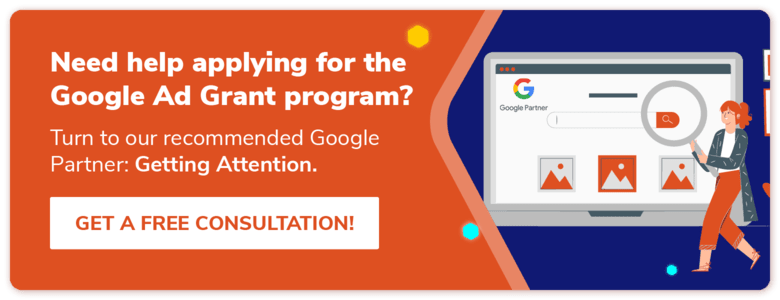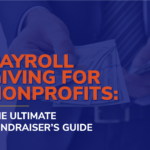Google Grant Application: How To Get Your Nonprofit Approved
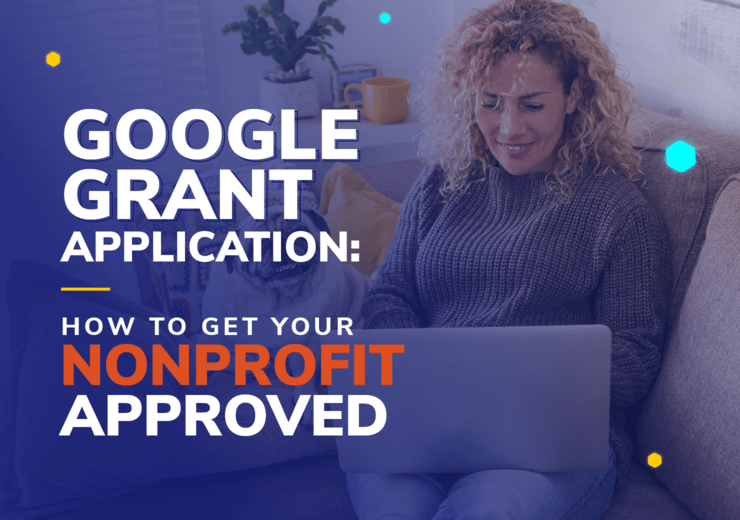
Applying for the Google Ad Grant can take your digital marketing to new heights. The program allows nonprofits like yours to tap into paid advertising for free. Whether you want to boost donations, promote your services, or amplify educational content about your cause on Google Search, the Google Ad Grant can help you get there.
While it’s an incredible marketing opportunity, the Google Grant application process can be lengthy, which might turn your nonprofit off from applying. Between creating your Google for Nonprofits account and preparing your website for approval, it can take a bit of time and effort. However, the free funding is undoubtedly worth it!
Plus, once you’re approved, you’ll never have to fill out the Google Grant application again. The grant will automatically renew each month (so long as you meet the ongoing Google Ad Grant requirements). To ensure you’re approved on the first try, we’ll teach you exactly how to apply for Google Grants by covering the following:
- The Basics of The Google Grant Application and Program
- How To Apply For The Google Ad Grant
- Getting Help With Your Google Ad Grants Application
A lot goes into getting started with the program, which is why we suggest partnering with a professional to complete your Google Grant application. Our recommended agency, Getting Attention, is a reliable partner for all your Google Grants needs. From guiding you through the application process to keeping your account compliant with ongoing requirements, they can help you achieve your digital marketing goals.
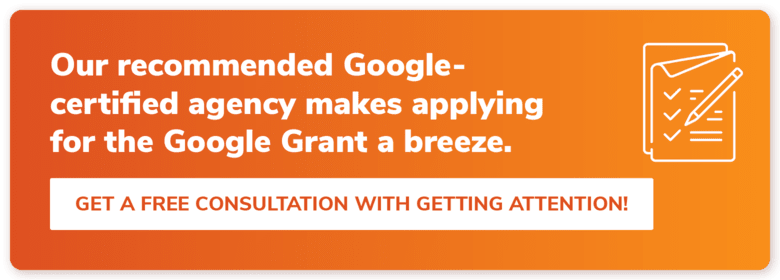
The Basics of The Google Grant Application and Program
Before starting the Google Grant application process, you should know a little bit about the program. Let’s explore some of the basics.
How do Google Grants work?
Google Ad Grants help show content on your nonprofit’s website to people searching for causes like yours online. Participants conduct keyword research, develop ads that target those keywords, and use ad credits to place their ads in strategic spots on Google search engine results pages (SERPs).
After successfully completing the Google Grant application, eligible nonprofits receive $10,000 in ad credits each month to promote their landing pages. That adds up to an incredible $120,000 in free marketing money each year.
Through the program, you can create paid ads at no cost to your organization. This will help drive traffic and increase visibility for your most important pages. For instance, you can:
- Amplify your donation page, events pages, and sponsorship opportunities to drive revenue.
- Promote your volunteer page and signup form.
- Share educational resources about your mission.
- Increase email newsletter subscriptions.
For instance, the Literacy Empowerment Foundation provides books and educational resources to children, parents, and teachers. Here’s an example of an ad from the foundation, which promotes its free educational resources on SERPs for keywords like “free books for kids”: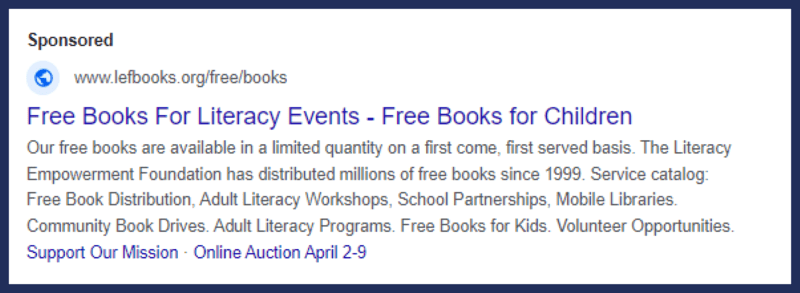
If you want to go beyond that $10,000 budget, you have to purchase additional Google Ads through a paid account. In most cases, that $10,000 is more than enough to increase your online presence.
There’s a ton you can accomplish with a smart Google Ad Grants management strategy. Plus, applying for the program means you’ll receive access to free analytics tools like Google Analytics and Google Tag Manager to track ad performance. However, applicants must go through a series of steps to qualify.
What’s the difference between Google Ads and organic search?
When you conduct a Google search, you’ll notice results labeled as “Sponsored.” These are Google Ads placed strategically among the organic (unpaid) results.
Here are some of the differences between ranking organically and paying for ad space:
- Control Over Placement: You have control over where and when your ads appear, allowing you to target specific keywords, demographics, locations, and times. You have less control over organic results as many factors are considered.
- Cost: Achieving high rankings is unpaid for organic search. Google Ads users are typically charged for each click on their ads. However, with the Google Ad Grant, nonprofits simply have to stay within their allotted budget.
- Results and Time Frame: It takes time to rank organically. Once you achieve high rankings, organic search can provide sustained traffic without ongoing paid advertising costs. Meanwhile, you have to continue paying for Google Ads placements.
Essentially, search engine optimization (SEO) is great for strengthening your online presence but can take some time to produce results. If you want to increase visibility for a time-sensitive project or event, the Google Ad Grant is the way to go. Think carefully about which pages are worth ranking organically versus what you’d rather pay to promote.
How long does it take to apply for Google Grants?
The time required to complete your Google Grant application varies based on how ready your organization is. For instance, if you already have a Google for Nonprofits account, you can skip a few steps in the process.
On the other hand, if your website doesn’t comply with Google’s website policy, you’ll need to spend time bringing it up to code before filling out your Google Grant application.
Generally speaking, here’s how long each step takes:
- Google for Nonprofits Account Setup: 0-14 business days
- Nonprofit Verification: 2-14 business days
- Google Ad Grants Pre-Qualification: 2-9 business days
- Google Ad Grants Account Setup: 6-29 business days
- Google Grant Application Review: Approximately 10 business days
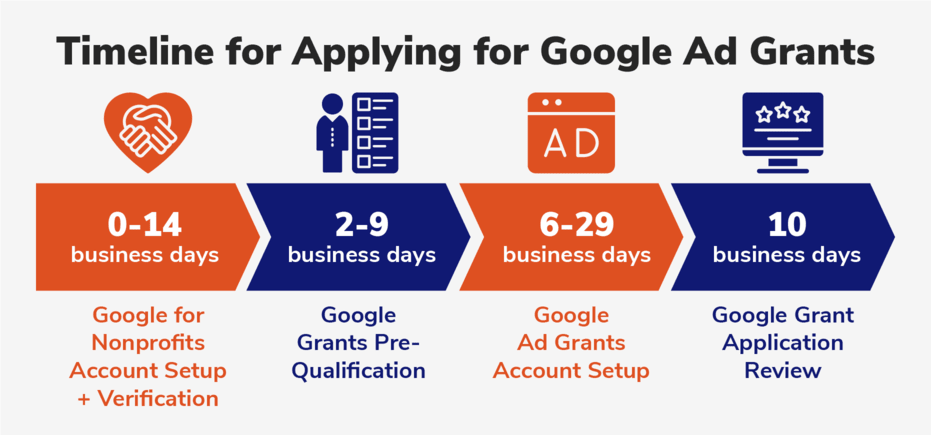
If your nonprofit hasn’t done any preparation, the whole process could take up to 2.5 months. While that seems like a lot of time, we recommend you don’t rush through the Google Grant application process. You want your application approved on the first try, so complete each step properly!
You can always outsource the work to a professional Google Grants manager. An expert can walk you through the process and speed things along since they understand each step thoroughly.
Are Google Ad Grants worth it?
Applying for the Google Ad Grant is incredibly beneficial. You can boost your website’s most important pages to the top of search results, helping you connect with likely supporters and beneficiaries. That’s especially helpful since 98% of searchers click a result on page 1 of Google search results.
According to this Google Grant Impact Report, Google owns over 90% of the global search engine market, and search ads have the highest ROI for nonprofits using paid advertising. Plus, view-through revenue makes up 26% of all giving sourced from digital ads, so even if people don’t click on your ad, you’ll spread awareness and inspire support.
Here are several reasons why Google Ad Grants are worth considering:
- Cost-Effective Marketing: With $10,000 per month in free advertising credits, your nonprofit can run cost-effective marketing campaigns without straining your budget.
- Awareness: Google Ads can help spread awareness about your cause, educate the public, and engage your audience thanks to advanced audience targeting capabilities.
- Boosted Fundraising Efforts: By driving more traffic to your donation pages, the Google Ad Grant can enhance your fundraising efforts and help you reach more potential donors.
- Volunteer Recruitment: Recruit nearby volunteers and reach individuals who are searching for nearby volunteer opportunities when you leverage geotargeting.
- Support and Resources: Google provides resources and support to help you optimize your campaigns and make the most out of the grant, minimizing the learning curve and maximizing your results.
In short, applying for the Google Ad Grant is worth it if you want to reach more donors, volunteers, advocates, sponsors, and beneficiaries. Plus, the program’s coordinators provide the support you need to be successful.
How To Apply For The Google Ad Grant
They don’t give everyone the Google Ad Grant! Instead, you have to follow the Google Grant application process to prove that you’re a legitimate organization that wants to boost its online presence. Here are the six easy steps you’ll need to follow to win and keep the grant.
Step 1) Meet the Google Ad Grant Application Requirements.
To qualify for Google Grants, you have to meet a series of basic requirements. If your organization doesn’t meet the criteria, your application will be rejected, which can set your timeline back. Luckily, Google is super clear with the guidelines it expects you to meet.
You can save your team a ton of time by knowing if you’re eligible before walking through the Google Grant application process. Chances are, your nonprofit already qualifies if it’s registered in your country and has a well-built website.
Here’s a rundown of the requirements applicants are expected to meet, as explained by Getting Attention’s guide to Google Grants eligibility:
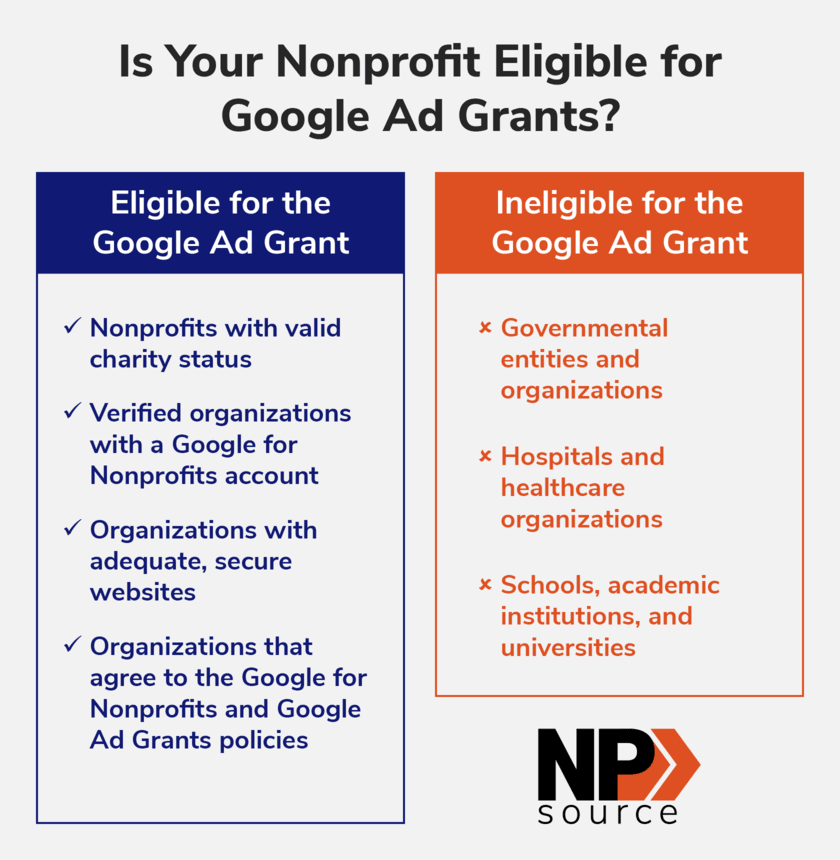
- Not be a governmental entity, hospital/healthcare organization, or academic institution. Google does make some exceptions, though. For instance, charitable arms or foundations associated with healthcare organizations are still eligible.
- Be registered in your country and have valid charity status. For U.S.-based nonprofits, that means that you need to have 501(c)(3) status.
- Create a Google for Nonprofits account and be verified. Not registered? We’ll walk you through how to get started in the next section.
- Have a secure website with substantial content about your mission. Google implements a website policy for Ad Grant applicants. To qualify, your website must be high-quality, clearly explain your mission, be hosted on your domain, and be secured with HTTPS certification.
- Agree to the Google for Nonprofits and Google Ad Grants policies. Some of these policies include not having a discriminatory mission and not promoting political content.
If you’re more of a visual learner, check out this video that explains the eligibility requirements for Google Grant applicants:
Unlike traditional grants, the Google Ad Grant is given to every organization that meets these requirements.
TL;DR: Confirm your eligibility before walking through the rest of the Google Grant application process.
Why do these requirements exist?
Google implements these standards to ensure valid, reputable nonprofits that will benefit from paid advertising receive the grant. Plus, that also means that any ads shown using Google Ad Grants won’t negatively impact the program.
These standards vary based on where your organization is located, so check the official eligibility guidelines for your country before filling out your Google Grant application.
Step 2) Create a Google for Nonprofits Account.
Next, create a Google for Nonprofits account to gain access to the Google Grant application. If you don’t already have an account, it’s pretty easy to register. Plus, if you already know you meet the Google Ad Grant requirements, then you’ll be eligible for this program, too!
Here’s how to get started:
- Visit the Google for Nonprofits registration website and click “Get started.”
- The system will walk you through the steps to request an account, including providing your tax ID, non-discrimination policies, and general contact and organization information.
- Agree to be contacted by Google and wait for verification.

Joining Google for Nonprofits will supply you with tons of perks, like free access to the entire suite of Google Workspace tools. From communication tools to specialized YouTube giving features, you’ll have everything you need to boost internal productivity and strengthen your digital marketing efforts.
TL;DR: You need a Google for Nonprofits account to gain access to the Google Grant application.
Step 3) Wait for Verification From GoodStack.
To ensure that only legitimate organizations receive the funding, Google implements a verification process. Verification is conducted through a trusted third-party entity called GoodStack. You don’t need to register with GoodStack separately, because your information will be submitted to them when you request a Google for Nonprofits account.
In addition to helping you access the Google Grant application, being verified by GoodStack also gives your organization other perks. GoodStack is a charitable commerce platform that lets users donate to their favorite causes alongside their routine shopping at no extra cost. Users link their credit or debit card to GoodStack and spend money at their featured retailers. Plus, registering with GoodStack means you’ll receive discounts and free access to valuable products like Google Workspace!
When you register for a Google for Nonprofits account, GoodStack will verify your organization. Sometimes, they need extra information, so watch for emails from their team. Most requests are reviewed within 3-5 business days, but verification can take up to 14 days.
TL;DR: Google works with a third-party organization to verify nonprofits’ validity during the Google Grant application process. Not only is this necessary, but registering with GoodStack can provide valuable discounts and fundraising opportunities.
Step 4) Prepare Your Website for the Google Grant Application.
While you wait for your account to be approved, now is a perfect time to bring your website up to code with the Google Ad Grant requirements. As we mentioned, they have a pretty thorough website policy you’ll need to follow if you want to join the program.
And there’s a good reason for this! Your website is one of the most vital parts of your strategy. It hosts the landing pages that you’ll promote using the Google Ad Grant, so you’ll want to make sure it’s prepared to engage visitors. From eye-catching designs to high-quality content, there’s a lot you can do to bring your website up to speed.
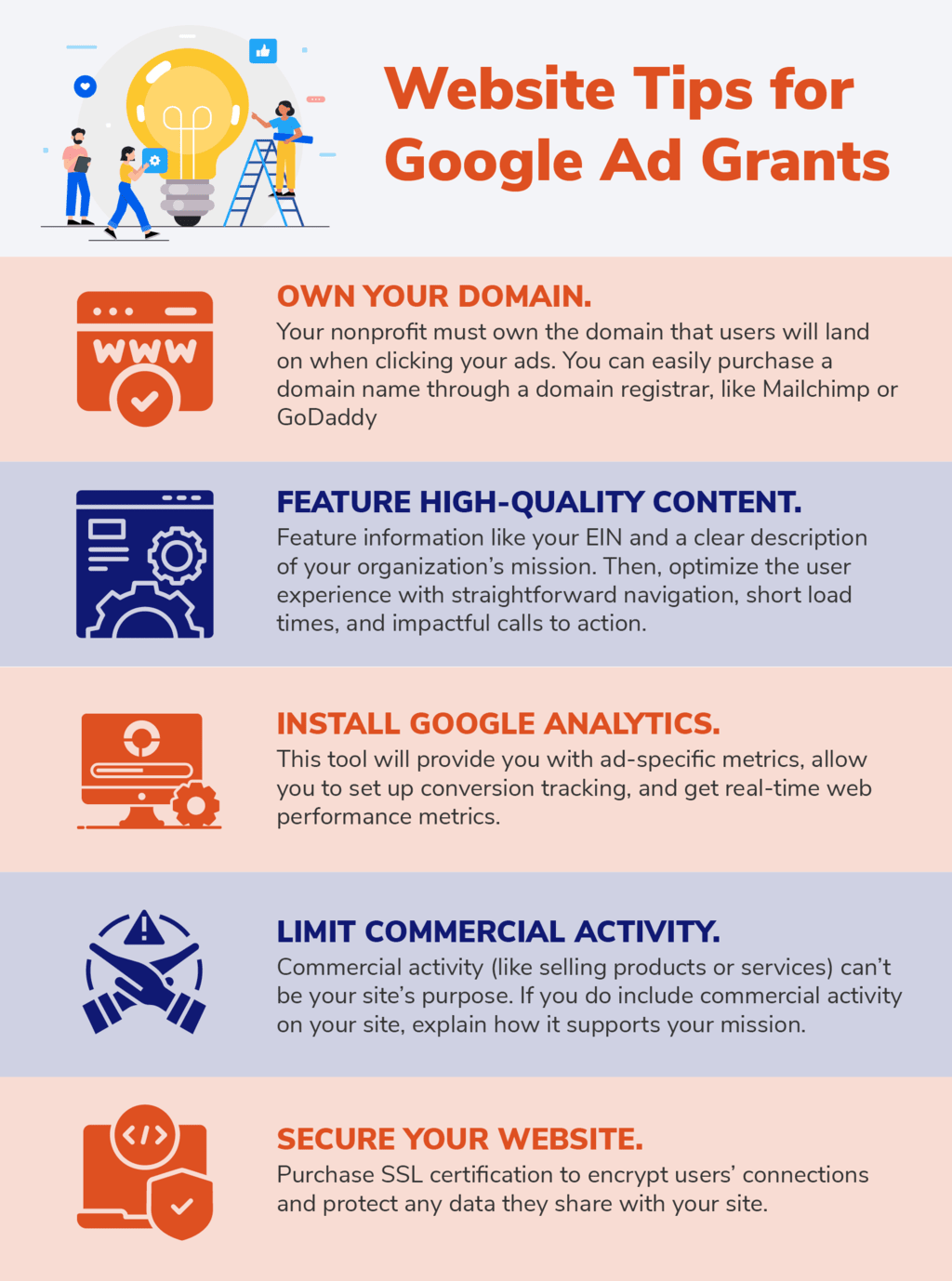
Make sure you own your domain.
This is the most basic requirement your site will need to meet. Per the Google Ad Grant requirements, your nonprofit must own the domain users will land on when clicking your ads.
Simply put, your website’s domain is what people will type into the address bar on their browsers to visit your site. If you own your domain, your URL should look something like yournonprofit.org/ instead of yournonprofit.wix.com/. You can easily purchase a domain name through a domain registrar like Mailchimp or GoDaddy.
If your nonprofit wants to drive traffic to your donation page that’s hosted on a third-party site, Google has specific rules for that. Your donation form must be hosted on one of Google’s approved donation processors, such as PayPal or Stripe.
Build out your website with high-quality content.
You’re going to promote your site’s content using Google Ad Grants, so their team wants to see that you have a high-quality site with plenty of promotable content. Plus, this will help drive more conversions (e.g., donations, volunteer sign-ups, etc.).
When overhauling your nonprofit’s website design, keep these elements in mind:
- Feature organization-specific information. You’ll need a clear description of your organization, mission, and activities. The most natural place to include this is on an ‘About’ page. If you’re a U.S.-based organization, put your EIN in the footer so that it appears across every page on your site. This signals that your organization is legitimate to the Google Ad Grants team and other users. Know that publicly displaying your EIN doesn’t pose any security threats. Rather, it helps build credibility and shows that you’re an authorized 501(c)(3) organization.
- Optimize your site for UX. The pages you’ll promote using the Google Ad Grant will drive more results if you offer a user-friendly experience. Feature straightforward navigation, impactful calls to action, and information regarding upcoming events. Then, quicken site speed, ensure content works well on mobile devices, and remove any broken links. Our guide to nonprofit web design explores layout options and design tips to improve your site’s UX.
These Google Ad Grant requirements make your website engaging for anyone who visits your site, whether they find it organically or via a paid ad.
Install Google Analytics.
The Google Ad Grant requirements state that you must report on results, such as through valid conversion tracking. We recommend using Google Analytics.
This platform provides ad-specific metrics and can show you the exact interactions people have on your site. This will give you the power to take charge of your digital marketing performance. By installing Google Analytics, you’ll be able to:
- Set up conversion tracking to monitor how often goals are achieved.
- See which pages on your site drive conversions.
- Get real-time performance metrics, such as changes in web traffic.
To get started, sign up for a free account and connect it to your website. Then, configure your account to tell Google Analytics what to track. Add tracking codes to the pages you want to monitor by copying the code the platform provides you. If you use a well-known CMS (like WordPress), plugins usually offer simpler ways to integrate Google Analytics into your website.
Limit commercial and advertising activity.
Google requires participants to limit commercial activities on their website. Commercial activity can’t be your site’s purpose, whether you’re selling products or services, offering consultations, or providing referrals.
So, if your site resembles a for-profit blog or business, your Google Grant application won’t be approved.
If you do include commercial activity on your site, you must explain how it supports your mission. For instance, let’s say you charge for your services. Somewhere on your site, you must explain how your organization uses those funds, such as by providing an annual report.
On a similar note, any advertising on your site must relate to your mission and not negatively affect the user experience. You also can’t host Google AdSense ads or affiliate advertising links.
Make your website secure.
When users land on your site, you want to assure them that your organization is trustworthy. That’s why you’ll need to confirm your site is secured with HTTPS on your Google Grant application. When you purchase an SSL certificate, it encrypts users’ connections, protecting any data they share with your website. Websites with SSL certification will include https in the address bar, while those without it only include http.
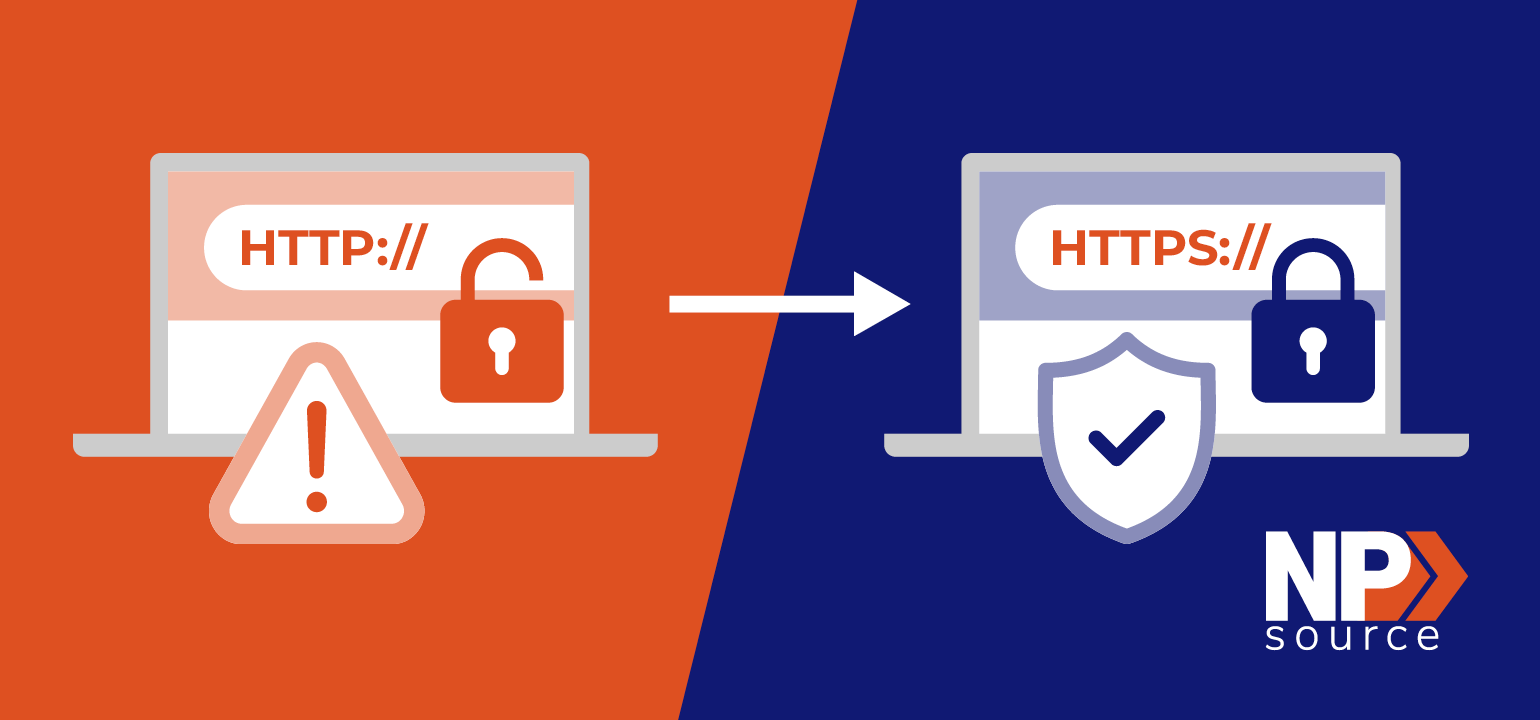 To obtain SSL certification, verify your website’s information through ICANN Lookup, generate a Certificate Signing Request (CSR), submit your CSR to your chosen certificate authority (like HubSpot), and install the certificate on your website.
To obtain SSL certification, verify your website’s information through ICANN Lookup, generate a Certificate Signing Request (CSR), submit your CSR to your chosen certificate authority (like HubSpot), and install the certificate on your website.
TL;DR: Google Grant applicants must have secure websites that explain their work thoroughly. That way, their ads will drive users to valuable content.
Step 5) Fill Out the Google Grant Application.
Once your Google for Nonprofits account is activated, you’ll have access to the Google Grant application.
To apply, first verify that your website is secure by logging into your Google for Nonprofits account. Click Get started under Google Ad Grants. Enter your website URL, and click Submit website.
Once your site is verified as being secure, you’ll fill out the eligibility form. This should take around 20 minutes and require you to submit some basic information about your organization. You’ll answer questions regarding your nonprofit’s mission and goals with the program.
Once you’ve submitted the eligibility form, return to the Google Ad Grants section within Google for Nonprofits. Click the checkbox confirming that you’ve filled out the eligibility form. Hit Submit activation request.

Congrats! You’ve officially applied for Google Ad Grants. The program coordinators will typically get back to you within 3 business days letting you know if you’re approved or not.
Taking your time throughout the application process is a must. You can also improve your Google Grant application experience by following these tips:
- Avoid entering any payment information. As you apply and when you set up your first campaign, you may be prompted to enter your payment details. Ignore this prompt, as it’s not necessary for the program and can actually derail your account setup.
- Keep track of your customer ID number. There will be a 10-digit number in the upper righthand corner that you need to pay attention to. This is your customer ID number, and you’ll need to submit it to Google for review later in the setup process.
- Note Google’s advice and try again if your application is denied. If Google rejects your application, read the reasons they give you for denial. Use this information to improve your application and try again.
- Get help from a Google Ad Grants agency. This is your best chance to simplify the process, get approved, and make the most of the program. We’ll dive into more detail later in this guide on how a Google Ad Grants agency can help.
If your application is approved, you’ll receive an email with further instructions for activating your account. From here, you can start creating campaigns and driving qualified traffic to your website through Google Ads.
TL;DR: The Google Grant application is straightforward and doesn’t take long to fill out. You’ll simply fill out a form with information about your nonprofit and the goals you hope to achieve with Google Ad Grants.
Step 6) Follow Google Ad Grant Requirements When Setting Up Your First Campaign
After getting your approval email, set up your Ad Grants account and start your first campaign!
Check out resources like our complete Google Ad Grants guide for tips on how to be successful with the program once you’re approved. You can also access plenty of free Ad Grants training to create stronger ads that drive results.
Above all, follow all of Google’s compliance requirements when you begin using the program, such as:
- Keyword requirements: Follow the Google Ad Grant requirements carefully when choosing the search keywords you want your ads to appear for. These rules only allow you to choose highly specific, multiple-word keywords with quality scores higher than 2.
- CTR requirements: Throughout your time in the program, your ads must maintain at least a 5% click-through rate (CTR) overall. This metric reassures Google that you’re using its funding effectively, and it allows your organization to make sure you’re creating appealing advertisements.
- General program requirements: To keep your Google Grant, you also need to abide by some general program rules, such as filling out Google’s annual survey. Read through the complete list of these guidelines to make sure you remain in good standing.
Along with complying with the Google Ad Grant requirements, continue using Google Analytics as you get started with the program to consistently evaluate your strategy and improve your ads’ approach. This is another area that a qualified Google Ad Grants agency can help you navigate.
TL;DR: Once your Google Grant application is approved, you’ll need to follow all of the program’s requirements to avoid losing your eligibility. As you set up your account and choose your first keywords, make sure you follow all of Google’s rules.
Getting Help With Your Google Grant Application
Getting denied from the program can set your timeline back. You’ll have to work with Google to determine why you don’t meet the Google Ad Grant requirements and resolve any issues. Instead, make sure you get approved the first time by turning to expert Google Grants management.
Choose a Google Grants advisor who fully understands the nuances of how to apply for Google Grants and get your organization approved. We recommend working with a Google Partner, like Getting Attention. Agencies with this title have undergone a certification process and demonstrated a sufficient understanding of the Google Ads platform. Not to mention, outsourcing work to a trusted professional will allow you to reinvest time into your mission.
Here’s what you can gain from hiring a third-party expert like Getting Attention to walk you through your Google Grant application and ongoing management:
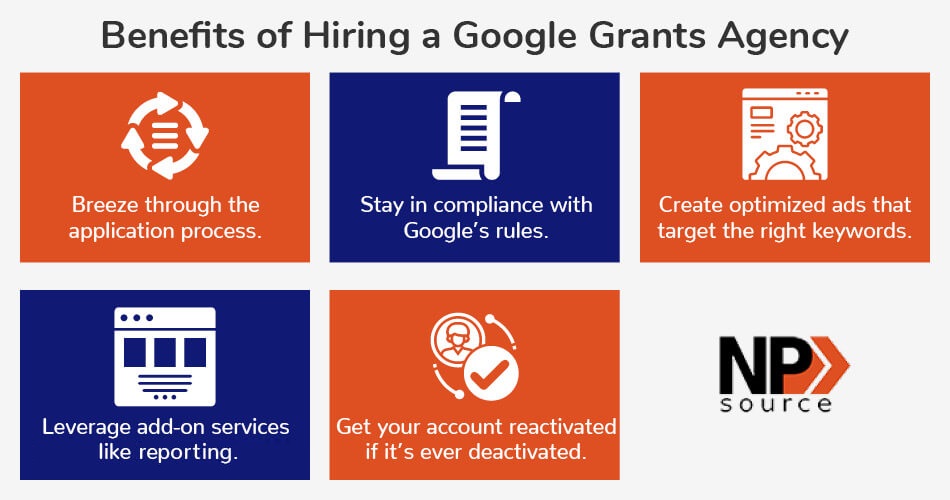
- Walk you through each step of applying to the program, so you can confirm your eligibility and fill out your Google Grant application.
- Comply with the Google Grant rules and keep your account in good standing.
- Optimize your ads and target the keywords your prospects are searching on Google based on extensive research.
- Stay in the loop with performance with services like reporting and monthly check-ins.
- Get your account reactivated if it ever lapses or gets suspended.
From guiding you through your Google Grant application to keeping your account compliant, Getting Attention will complete everything you need to get started and make the most of the program.
They’ll act as an extension of your team, working with you to understand your broader digital marketing goals and fold Google Grants into achieving those objectives. Working with a Google Partner, in particular, will give you a direct line to the program’s coordinators since your Google Grants manager will be the first to hear about any program updates.
If this sounds like an offer you can’t refuse, reach out to their team to get started. Plus, they’re open to chatting about their expertise in areas other than what’s listed on their website.
Final Thoughts on Google Grant Applications
Applying for Google Grants takes time and effort, but it’ll pay off as you grow your digital presence. Each step in the process is an opportunity to rethink your organization’s image online. In other words, don’t fly through applying!
A certified Google Ad agency like Getting Attention can help you maximize the program’s value by simplifying the application process and championing your cause at every turn. In no time, you’ll be up and running with the program, so you can drive more conversions through paid advertising.
As you wait for your Google Grant application to be approved, dive into all the great things the program offers with these resources:
- Hiring A Google Grants Manager: A Guide & 9 Agencies. Completing your Google Grant application is simpler with an expert on your side. Learn how to partner with a Google Grants agency by reading this guide.
- How to Apply for Google Grants: Get Approved in These Easy Steps. Still confused about how to apply for Google Grants? This guide from Getting Attention shares some more insight!
- Google Ad Grants: The Complete Guide + How to Get Started. Explore everything you need to know about the Google Ad Grant program, including proven tips and common goals.


